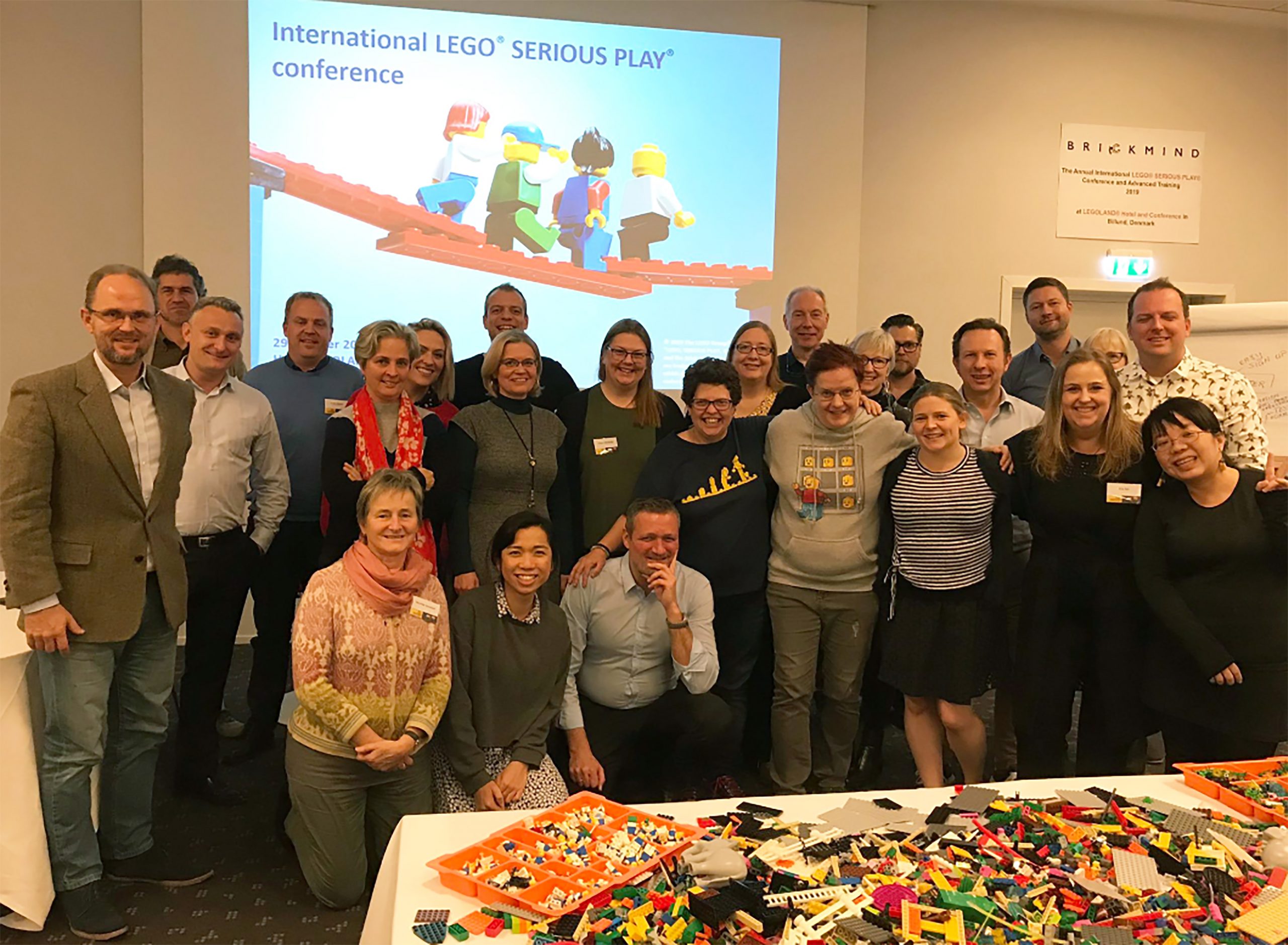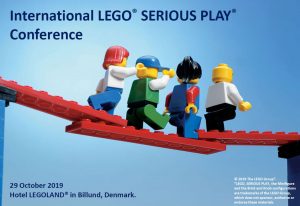
Back in 2017 I completed my training as a Lego® Serious Play® facilitator, and also visited the inaugural LSP Conference in Billund: you can read about my experiences in this earlier blog post.
Recently I was back in Billund for the 3rd International Lego® Serious Play® (LSP) Conference: much has changed in those two years, both for me and for LSP in Higher Education, and this blog post reflects on my LSP learning journey as well as reporting on the conference itself. It was lovely to be back with my LSP ‘family’: this is a very warm and supportive community, and it was a joy to reunite with old friends and meet new ones.
The conference, led by CEO of Inthrface (Danish LSP Training Company) Micael Buckle, aimed to provide both a strong sense of community among trained facilitators while also providing ways to share and develop LSP practice. Attendees were truly global, representing the USA, South America, Australia, Belgium, Finland and many more, plus a few of us from the UK. As well as those working within education, independent consultants and in-house training developers were also represented.
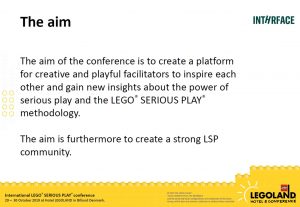
The first session was delivered by Matt Bannister of RADA Business: the title ‘The power of storymaking and story telling’ making perfect sense due to LSP’s ability to foster skills in storytelling. He discussed the way that stories can carry and communicate our values, creating an emotional connection with others.
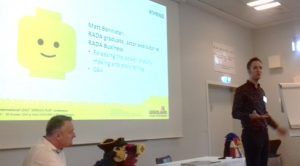
We began with some lively role play, including a dialogue with one another using “Hello!”, “You’re Late!” and “I know!” in varying tones of voice and body language. A refreshing and hilarious ice-breaker, making the point that it’s all about the way that you tell the story. Then it was time to consider storytelling structure: Matt introduced a framework (below) and we were invited to use this to tell our own story. He stressed the importance of the ‘Inciting Incident‘: the point where change became inevitable in our stories. Matt made the point that this incident may be the most memorable part of our story, and to consider starting with this, or switching the order around in other ways, such as starting with the ending in order to get our story across more effectively.
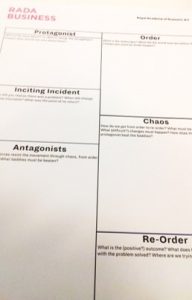
I found Matt Bannister’s session to be highly relevant to a HE teaching context, both in terms of how we use stories to shape and communicate our own academic identities but also in relation to the fostering of storytelling with students in order to create a stronger sense of self and to support wellbeing (I’ve found LSP and collage both excellent vehicles for this).
Next we heard from Johan Roos, Professor at HULT International Business School and co-inventor of the Lego® Serious Play® methodology. Johan presented some initial findings from his research on the way that LSP can impact on increasing readiness for change: he discussed some of the enablers for this process such as creating a sense of excitement and making sure that participants don’t feel intimidated by the process and withdraw. This topic links directly to the new Readiness for Change Advanced LSP training developed by Inthrface: this was offered to attendees the day prior to the conference. Please contact Johan if you would like to be involved in this ongoing research.
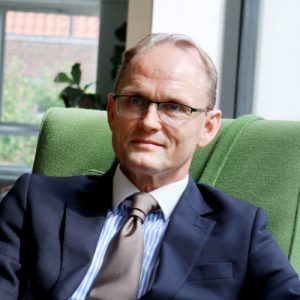
With change management being such an important issue in the constantly evolving UK HE landscape, LSP would seem to be a perfect tool to enable us to develop the required creativity and agility of thought.
Johan was then joined by the other co-inventor of LSP: Bart Victor, Cal Turner Professor of Moral Leadership at Vanderbilt University, who spoke to us via video link. Bart and Johan chatted about their experiments with Lego® bricks 20 years ago that led to the development of the LSP methodology: you can read about the invention of LSP in their article ‘How It All Began: The Origins Of LEGO® Serious Play®’
I was particularly interested to hear that one of the methods they tried was to use only bricks of one colour, including white-only bricks: something I now use myself for mindful activities (see this blog post from the Playful Learning conference).
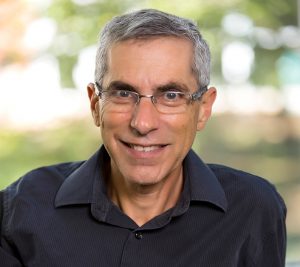
Bart also talked about the way that activities such as LSP that link to childhood and playfulness are particularly needed during times of disruption and transition: very pertinent whether we are looking at local or global issues. I welcomed Bart’s view that we are currently experiencing an analogue backlash in response to mass digitisation: he stressed the importance of returning to the senses, something I value as a practitioner of multi-sensory learning.
We next heard from Esben Stærk, President of LEGO® Education, about the work that LEGO® Education have been doing in schools over the past 40 years in building key life skills including creative thinking and problem solving through play.
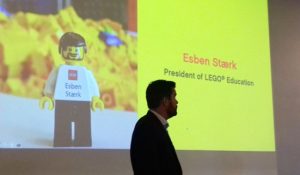
He shared findings from a research project that aimed to understand the role that confidence plays in STEAM learning (putting the Art into STEM): it identified the way that hands-on learning builds learner confidence in school settings.
So many of the findings discussed were relevant to students in UK HE: the benefits of active learning, the focus on taking risks and embracing failure plus the positive impact of playful learning on both student confidence and the acheivement of learning outcomes.
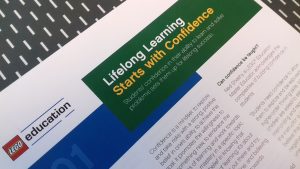
We then had the chance to get hands-on ourselves: using brand new SPIKE™ Prime kits designed for use in primary STEAM Education we worked in teams to build a programmed model. Our model had to meet the following specifications: it must move forward but must not have wheels. The kits incorporated some simple coding based on Scratch as well as more familiar LEGO® elements and could be made to move in different ways and at different speeds using motors and sensors.
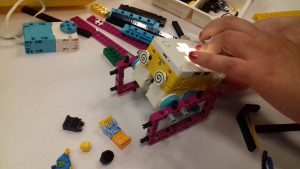
This was most definitely out of my comfort zone, and I found the task quite challenging in a completely different way to LSP. The task was extremely engaging though, and very rewarding once we actually got our model to work: we then held a race to see which model best met the criteria, resulting in much amusement all round…
The day was rounded off with, appropriately enough, some hands-on LSP building led by Johan: the twist was, that we were invited to combine soft materials such as felt and pipe cleaners with LEGO® bricks in our models.
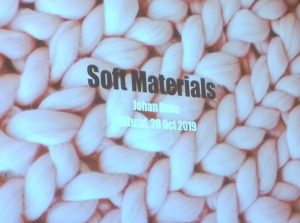
I had been intrigued two years before by Johan’s suggestion that softer materials may strengthen the emotional aspects of LSP activities, and have experimented with this idea in my own teaching, using pipe cleaners to form connections between models.
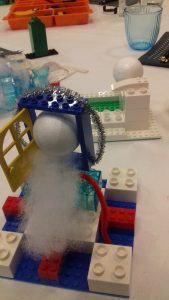
This process raised some interesting questions among participants. Does a greater mix of material help or hinder the story? Does it mean that aesthetics can get in the way and models become purely decorative? Lots of food for thought here: in my experience, limited amounts of additional materials can be beneficial, sometimes on a purely practical level, e.g. post-its to annotate models. Having too many materials to choose from though can mean that the inventive, metaphorical thinking central to LSP can get lost.
Day two of the conference focussed on the LSP Facilitator Community, with presentations from members from around the world. These included my personal LSP heroine, NTF Alison James: she shared her many and varied LSP-related publications and events including her recent TEDx talk, publication with Chrissi Nerantzi, ‘LEGO® for university learning: inspiring academic practice in higher education‘ and a mention of her role as a judge at DMU’s LSP Competition (see earlier blog post).
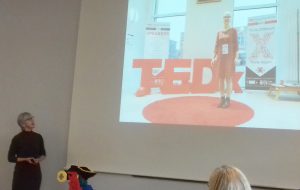
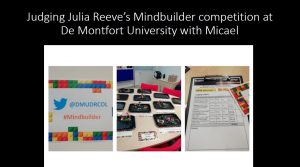
Veron Lai, Service Design Consultant and Lecturer at University of the Arts, gave a presentation entitled Designing the Future, where she shared insights from applications of LSP in diverse contexts from youth work to retail. The work she had done with young people on creative identity building really resonated with me. For example, Veron has used LSP in her MA Service Design teaching to allow a diverse cohort of students from 14 different countries to both share their own narratives and overcome language barriers.
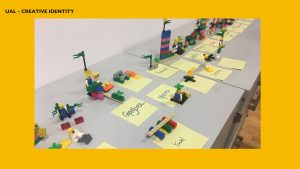
Then it was my turn: I shared the way that my LSP training has impacted on my teaching practice, enabling me to re-contextualise my other creative pedagogic approaches. I also shared my LSP-informed activities over the past two years, including initiatives with DMU staff, researchers and students. You can view the slides here: ‘Weaving creative learning into UK HE‘.
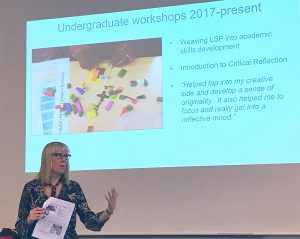
I concluded my talk by sharing two LEGO® models: the grey one represents my learning and teaching practice prior to my training in LSP: there are individual blocks of colourful, creative practice but the connections (if any) are loose and fuzzy. The second, white model, is unified by a grounding in mindful, compassionate pedagogy: some bricks are more transparent showing deeper reflection on practice, some are darker in colour showing deeper learning and some are higher, showing more visibility of my work.
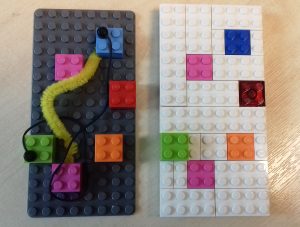
It’s been a surprising and exhilarating voyage of discovery over the past couple of years, and the conference has provided fresh insight and inspiration for embedding creative pedagogy into the curriculum. Watch this space to find out where LSP goes next…
If you’re interested in coming along to the conference next year, here’s a date for your diary…
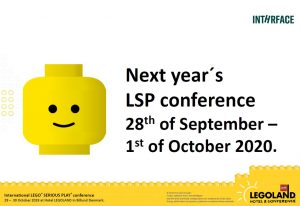
Please let me know if you would like to submit a blog post, and do get in touch if you would like to chat about playful learning.
Happy building!
Julia
